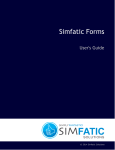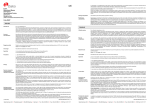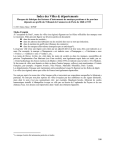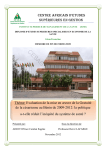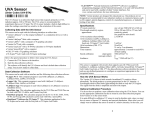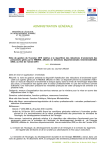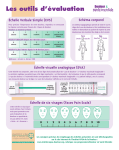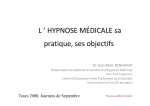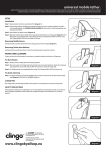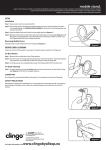Download 19073537
Transcript
Visual Analogue Scale (VAS) Plusieurs auteurs depuis 1974 Instrument mesure Abréviation de Visual Analogue Scale VAS Auteur Huskisson, E. C. (1974). Measurement of pain. Lancet, 2, 11271131. Thème Management des symptômes de la douleur Objectif Evaluer la douleur chez le patient Population Non spécifiée Relevé Nombre d’items Dispensateur de soins 1 item Présence du Oui patient requise Localisation de l’instrument de http://www.ndhcri.org/ mesure Objectif Contrôle de la douleur chez le patient à l’aide d’un autorapport sur une échelle à un item. Groupe cible Le groupe cible visé par la Visual Analogue Scale (VAS) est divers. La validité de l’instrument de mesure a déjà été étudiée chez des enfants/ adolescents (Stinson, Kavanagh, Yamada, Gill, & Stevens, 2006), chez des adultes (Bijur, Silver, & Gallagher, 2001; Carey, Turpin, Smith, Whatley, & Haddox, 1997), ainsi que chez des personnes âgées (Carey, Turpin, Smith, Whatley, & Haddox, 1997; Mawdsley, Moran, & Conniff, 2002; Pautex et al., 2006). Des études valident l’utilisation de la VAS pour diverses catégories de patients telles que les patients en service de chirurgie (Gagliese, Weizblit, Ellis,& Chan, 2005; Jensen, Chen, & Brugger; 2002), les déments (Pautex et al., 2005; Pautex et al., 2006), les patients souffrant de problèmes musculo-squelettiques (Mawdsley et al., 2002; Pomeroy et al., 2000; Tamiya et al., 2002; Triano, McGregor, Cramer, & Emde, 1993) et d’autres patients présentant des formes spécifiques de douleur (Crossley, Bennell, Cowan, & Green, 2004; Freeman, Smyth, Dallam, & Jackson, 2001; Gallagher, Bijur, Latimer, & Silver; 2002; Gagliese & Katz, 2003). Par conséquent, l’utilisation de la VAS comme instrument de mesure pour le management de la douleur peut être généralisée pour une large population de patients. Description La VAS est une ligne de 100 mm dont les deux extrêmes sont limités par les termes « Aucune douleur » et « Pire douleur possible ». L’intention est que le patient indique sur la ligne l’intensité de la douleur qu’il ressent au moment du relevé. L’écart entre le point zéro (« Aucune douleur ») et le marquage du patient est ensuite mesuré en mm par le dispensateur de soins. La version la plus connue de la VAS a une ligne d’orientation horizontale, bien qu’une orientation verticale soit aussi courante pour l’évaluation de la douleur du patient. Il existe de nombreuses variantes à la version originale de la VAS. Des différences se retrouvent notamment da ns la terminologie que l’on utilise pour délimiter le point final (ex. douleur extrême, douleur la plus atroce, …), la présence de pointillés de séparation sur l’échelle et l’unité de longueur utilisée (cm ou mm). Fiabilité La VAS présente une haute fiabilité. Cela peut être amplement étayé à l’aide de résultats de différentes études qui ont déjà été réalisées. De nombreuses études font état d’une intra-rater reliability de 0.90 et plus (Bijur et al., 2001; Mawdsley, 2002; Pautex et al. 2005; Pautex et al., 2006). Quelques études mentionnent même une valeur de 0.99 (Gallagher et al., 2002; McGrath et al., 1985 in Stinson et al., 2006). Le nombre d’études avec une faible intra-rater reliability (r < 0.75) est limité (Pomeroy et al., 2000; Tamiya et al., 2002). De plus, nous notons que les mesures répétées sont caractérisées, dans ces études, par de grands intervalles temporels (> 1 jour), ce qui explique peut-être la variabilité des scores de douleur à la suite de changements dans le vécu de la douleur. Des résultats positifs sont également générés pour l’interrater reliability. Dans les études retrouvées, cette corrélation est toujours supérieure à 0.70 (Benaim et al, 2007; Herr, Spratt, Mobily, & Richardson, 2004; Pautex et al. 2005; Pautex et al., 2006). Le coefficient alpha de Cronbach entre la VAS et d’autres échelles de mesure à un item a été vérifié dans l’étude de Herr et al. (2004) et dans l’étude de Carey et al. (1997). La corrélation atteignait respectivement α = 0.97 (VAS – Numeric Rating Scale – Verbal Descriptor Scale – Verbal Numeric Scale – Faces Pain Scale) et α = 0.88 (VAS – Faces Rating Scale – Numeric Rating Scale). Validité La VAS est un instrument de mesure valide pour l’appréciation de la douleur. Plusieurs études ont comparé des scores VAS de patients avec des scores sur d’autres échelles de douleur (Benaim et al, 2007; Freeman et al., 2001; Hicks, von Baeyer, Spafford, Korlaar, & Goodenough, 2001; Gagliese et al., 2005; Kim & Buschmann, 2006; Mawdsley et al., 2002; Pautex et al. 2005; Pautex et al., 2006; Stinson et al., 2006; van Dijk, Koot, Saad, Tibboel, & Passchier, 2002). La corrélation plutôt importante entre la VAS et d’autres échelles de valeur valides confirme la concurrent validity de l’échelle. Afin de vérifier la construct validity de la VAS, Gagliese et al. (2005) et Herr et al. (2004) ont effectué une analyse des principaux composants. Dans les deux études, 1 facteur a été abstrait au départ des scores de douleur sur les différents instruments de mesure à un item. Des corrélations significatives ont également été rapportées entre des scores VAS et l’administration d’analgésiques (Abu-Saad & Holzemer in Stinson et al., 2006; Aradine et al. in Stinson et al., 2006; Gagliese & Katz, 2003; Tyler et al. in Stinson et al., 2006), le taux de protéine C réactive (Tamiya et al., 2002), l’intensité de la douleur causée (Herr et al., 2004), des observations comportementales chez des patients souffrant de douleurs (Koho, Aho, Watson, & Hurri, 2001), … La sensitivité de la VAS est confirmée par des études avec un repeated measures design (Crossley et al., 2004; Jensen et al., 2002). Ces études ont corrélé les scores VAS de patients à des enregistrements de douleur entre les différentes mesures. Les évolutions de la douleur rapportées par les patients (« ma douleur a augmenté ou a diminué) étaient nettement rattachées aux scores VAS. Utilisation de la VAS chez les enfants La VAS a déjà été amplement étudiée chez les enfants et fait état d’une bonne validité pour la plupart des enfants à partir de l’âge de 8 ans (Champion et al. in Stinson et al., 2006). La VAS est toutefois moins indiquée pour les enfants de moins de 8. La fiabilité de l’instrument de mesure diminue dans cette catégorie d’âge (Beyer and Aradine in Stinson et al., 2006; Shields et al. in Stinson et al., 2006). La Faces Pain Scale peut représenter une possible alternative pour la population composée des enfants âgés de moins de 8 ans. Utilisation de la VAS chez les personnes âgées Une étude démontre que les personnes âgées peuvent éprouver des difficultés à compléter et à comprendre la VAS (Freeman et al., 2001; Herr, Mobily, Kohout & Wagenaar, 1998; Jensen & Karoly in Dworkin et al., 2005; Pautex et al., 2005; Pautex et al., 2006). C’est particulièrement le cas pour les personnes d’un âge avancé et les déments pour lesquels, par exemple, la Faces Pain Scale ou la Verbal Rating Scale sera plus indiquée. Il est fait état de plus de problèmes avec l’utilisation de la VAS horizontale en comparaison avec la VAS verticale. La VAS verticale est recommandée, étant donné que cet instrument de mesure génèrerait moins de relevés erronés et serait plus facilement compréhensible pour les personnes âgées (Gagliese et al., 2005). Convivialité La convivialité de la VAS a été évaluée par 33 dispensateurs de soins travaillant dans les services d’oncologie médicale/radiothérapie et d’oncologie pédiatrique de l’hôpital universitaire de Gand. 94% des personnes interrogées constatent que la VAS peut être relevée en moins de 3 minutes. De plus, la plupart des dispensateurs de soins sont d’avis que la VAS est simple à compléter (85%) et est claire et univoque (91%). Le mode d’emploi est également précis pour 94% des dispensateurs de soins. L’évaluation de la convivialité de la VAS est donc extrêmement positive. Notons toutefois que 1 dispensateur de soins sur 2 est d’avis qu’une formation complémentaire est requise pour l’utilisation de l’instrument de mesure. Remarques Plusieurs études font état de difficultés chez des patients pour compléter la VAS (Gagliese et al., 2005; Herr et al., 2004; Paice & Cohen 1997; Pautex et al., 2006). Des comparaisons entre la VAS et la Numeric Rating Scale (NRS) montrent que l’utilisation de cette dernière échelle pose moins de problèmes. De plus, la NRS bénéficie aussi d’une fiabilité/validité élevée et comparable. En outre, les patients indiquent eux-mêmes qu’ils préfèrent la NRS et d’autres échelles de douleur à la VAS (Carey et al., 1997; Dworkin et al., 2005; Gagliese et al., 2005; Herr et al., 2004; Paice & Cohen 1997). Cela peut indiquer que la NRS est plus indiquée que la VAS pour l’évaluation de la douleur. Plusieurs études de validation recommandent donc la NRS comme étant l’instrument le plus adéquat pour l’évaluation de la douleur (Downie et al., 1978; Dworkin et al., 2005; Jensen et al., 2003). Cela doit être quelque peu nuancé, étant donné qu’aucune échelle de douleur ne peut être utilisée pour toutes les formes de douleur ou pour toutes les catégories d’âge. Références Benaim, C., Froger, J., Cazottes, C., Gueben, D., Porte, M., Desnuelle, C., & Pelissier, J. Y. (2007). Use of the Faces Pain Scale by left and right hemispheric stroke patients. Pain, 128, 52-58. Bijur, P. E., Silver, W., & Gallagher, E. J. (2001). Reliability of the visual analog scale for measurement of acute pain. Acad Emerg Med, 8, 1153-1157. Carey, S. J., Turpin, C., Smith, J., Whatley, J., & Haddox, D. (1997). Improving pain management in an acute care setting. The Crawford Long Hospital of Emory University experience. Orthop.Nurs., 16, 29-36. Crossley, K. M., Bennell, K. L., Cowan, S. M., & Green, S. (2004). Analysis of outcome measures for persons with patellofemoral pain: which are reliable and valid? Arch Phys Med Rehabil, 85, 815-822. Downie, W. W., Leatham, P. A., Rhind, V. M., Wright, V., Branco, J. A., & Anderson, J. A. (1978). Studies with pain rating scales. Ann Rheum Dis, 37, 378-381. Dworkin, R. H., Turk, D. C., Farrar, J. T., Haythornthwaite, J. A., Jensen, M. P., Katz, N. P. et al. (2005). Core outcome measures for chronic pain clinical trials: IMMPACT recommendations. Pain, 113, 9-19. Freeman, K., Smyth, C., Dallam, L., & Jackson, B. (2001). Pain measurement scales: a comparison of the visual analogue and faces rating scales in measuring pressure ulcer pain. J.Wound.Ostomy.Continence.Nurs., 28, 290-296. Gagliese, L. & Katz, J. (2003). Age differences in postoperative pain are scale dependent: a comparison of measures of pain intensity and quality in younger and older surgical patients. Pain, 103, 11-20. Gagliese, L., Weizblit, N., Ellis, W., & Chan, V. W. (2005). The measurement of postoperative pain: a comparison of intensity scales in younger and older surgical patients. Pain, 117, 412-420. Gallagher, E. J., Bijur, P. E., Latimer, C., & Silver, W. (2002). Reliability and validity of a visual analog scale for acute abdominal pain in the ED. Am.J.Emerg.Med., 20, 287290. Herr, K. A., Mobily, P. R., Kohout, F. J., & Wagenaar, D. (1998). Evaluation of the Faces Pain Scale for use with the elderly. Clin J Pain, 14, 29-38. Herr, K. A., Spratt, K., Mobily, P. R., & Richardson, G. (2004). Pain intensity assessment in older adults: use of experimental pain to compare psychometric properties and usability of selected pain scales with younger adults. Clin.J.Pain, 20, 207-219. Hicks, C. L., von Baeyer, C. L., Spafford, P. A., van, K., I, & Goodenough, B. (2001). The Faces Pain Scale-Revised: toward a common metric in pediatric pain measurement. Pain, 93, 173-183. Jensen, M. P., Chen, C., & Brugger, A. M. (2002). Postsurgical pain outcome assessment. Pain, 99, 101-109. Jensen, M. P., Engel, J. M., McKearnan, K. A., & Hoffman, A. J. (2003). Validity of pain intensity assessment in persons with cerebral palsy: a comparison of six scales. J Pain, 4, 56-63. Kim, E. J. & Buschmann, M. T. (2006). Reliability and validity of the Faces Pain Scale with older adults. Int J Nurs Stud., 43, 447-456. Koho, P., Aho, S., Watson, P., & Hurri, H. (2001). Assessment of chronic pain behaviour: reliability of the method and its relationship with perceived disability, physical impairment and function. J Rehabil Med, 33, 128-132. Mawdsley, R. H., Moran, K. A., & Conniff, L. A. (2002). Reliability of two commonly used pain scales with elderly patients. Journal of Geriatric Physical Therapy, 25, 1620. Paice, J. A. & Cohen, F. L. (1997). Validity of a verbally administered numeric rating scale to measure cancer pain intensity. Cancer Nurs, 20, 88-93. Pautex, S., Herrmann, F., Le Lous, P., Fabjan, M., Michel, J. P., & Gold, G. (2005). Feasibility and reliability of four pain self-assessment scales and correlation with an observational rating scale in hospitalized elderly demented patients. J.Gerontol.A Biol.Sci.Med.Sci., 60, 524-529. Pautex, S., Michon, A., Guedira, M., Emond, H., Le Lous, P., Samaras, D. et al. (2006). Pain in severe dementia: self-assessment or observational scales? J Am Geriatr Soc, 54, 1040-1045. Pomeroy, V. M., Frames, C., Faragher, E. B., Hesketh, A., Hill, E., Watson, P. et al. (2000). Reliability of a measure of post-stroke shoulder pain in patients with and without aphasia and/or unilateral spatial neglect. Clin.Rehabil., 14, 584-591. Stinson, J. N., Kavanagh, T., Yamada, J., Gill, N., & Stevens, B. (2006). Systematic review of the psychometric properties, interpretability and feasibility of self-report pain intensity measures for use in clinical trials in children and adolescents. Pain, 125, 143-157. Tamiya, N., Araki, S., Ohi, G., Inagaki, K., Urano, N., Hirano, W. et al. (2002). Assessment of pain, depression, and anxiety by visual analogue scale in Japanese women with rheumatoid arthritis. Scand J Caring Sci, 16, 137-141. Triano, J. J., McGregor, M., Cramer, G. D., & Emde, D. L. (1993). A comparison of outcome measures for use with back pain patients: results of a feasibility study. J.Manipulative Physiol Ther., 16, 67-73. van Dijk, M., Koot, H. M., Saad, H. H., Tibboel, D., & Passchier, J. (2002). Observational visual analog scale in pediatric pain assessment: useful tool or good riddance? Clin.J.Pain, 18, 310-316. Localisation de l’instrument de mesure http://www.ndhcri.org/ VISUAL ANALOGUE SCALE (VAS) VERSCHEIDENE AUTEURS SINDS1974 Author (year) Setting Sample (n) Design Reliability Validity Pautex, S., Michon, A., Guedira, M., Emond, H., Le Lous, P., Samaras, D. et al. Geriatrics hospital and a geriatric psychiatry service. 129 patients aged 65 and older hospitalized during a 15 month-period who met DSM criteria for dementia, with a Mini-Mental State Examination score less than 11 and a Clinical Dementia Rating of 3 or greater. (n = 129) Repeated measures design: Patients were asked to indicate their current level of pain on different scales (VAS, Faces Pain Scale and Verbal Rating Scale). This was repeated 30 minutes later either by the same investigator (50% of the cases) or by a different examiner who was blinded to the first assessment. S E CrV Toronto General Hospital, University Health Network and Mount Sinai Hospital, Toronto, Ontario. Patients scheduled to receive patientcontrolled analgesia following general surgery. (n = 504) Comparative study: the VAS was compared with the Numeric Rating Scale (NRS), the Verbal Descriptor Scale (VDS) and the pain intensity measures of the McGill Pain Questionnaire (MPQ). (2006) Gagliese, L., Weizblit, N., Ellis, W., & Chan, V. W. (2005) FV CrV CsV Reliability: Stability (S), Internal consistency (IC), Equivalence (E) Validity: Face validity (FV), Content validity (CtV), Criterion validity (CrV), Construct validity (CsV) Sensitivity (Sen), Specificity (Sp), Positive Predictive Value (PPV), Negative Predictive Value (NPV), Receiver Operating Curve (ROC), Likelihood Ratio (LR), Odds Ratio (OR) Results reliability Results validity Commentary (S) Intra-rater reliability: R = 0.98 (p < 0.001) (CrV) Concurrent validity: - Correlation between VAS and different scales at first assessment: 1. Correlation VAS – Verbal Rating Scale: r = 0.67 (p<0.001) 2. Correlation VAS – Faces Pain Scale: r = 0.45 (p<0.001) 3. Correlation VAS – Doloplus 2 (observational pain scale): r = 0.25 (p<0.001) - Correlation between VAS and different scales at second assessment: 4. Correlation VAS – Verbal Rating Scale: r = 0.73 (p<0.001) 5. Correlation VAS – Faces Pain Scale: r = 0.66 (p<0.001) 6. Correlation VAS – Doloplus 2 (observational pain scale): r = 0.24 (p<0.001) Weak correlations between VAS and Doloplus 2. (FV) Face validity; Patients rated the VAS as the least accurate and least preferred instrument for future assessments.The VAS had the highest proportion of patients making errors (p ≤ 0.005). The vertical VAS was associated with lower error rates and greater face validity than the horizontal VAS. (E) Interrater reliability: R = 0.88 (p < 0.001) A significant better comprehension of the Verbal Rating Scale (VRS) and the Faces Pain Scale (FPS) scale was found. This might suggest that the VAS is not the most appropriate pain assessment scale for patients with severe dementia. (CrV) Concurrent validity: - Correlation between VAS and VDS and NRS: 1. Patients aged > 60 years: r = 0.60-0.93 (p<0.001) 2. Patients aged ≤ 60 years: r = 0.72-0.91 (p<0.001) - Correlation between VAS and MPQ was lower. (CsV) Principal components analysis: A one-factor model was extracted from the different measurement scales and accounted for 82% of the total variance in the young group and 85% of the variance in the older group. Factor loadings were 0.95 for horizontal VAS and 0.91 for vertical VAS. Reliability: Stability (S), Internal consistency (IC), Equivalence (E) Validity: Face validity (FV), Content validity (CtV), Criterion validity (CrV), Construct validity (CsV) Sensitivity (Sen), Specificity (Sp), Positive Predictive Value (PPV), Negative Predictive Value (NPV), Receiver Operating Curve (ROC), Likelihood Ratio (LR), Odds Ratio (OR) Author (year) Setting Sample (n) Design Freeman, K., Smyth, C., Dallam, L., & Jackson, B. Hospital. Adults who had one or more stage 1 to 4 pressure ulcer, and had some ability to explain their pain experience. (n = 44) Comparative study: the VAS was compared with the Faces Rating Scale (FRS). 2 urban emergency departments. Convenience sample of patients with the chief complaint of acute abdominal pain. (n = 101) Repeated measures design: VAS measurements 1 minute apart every 30 minutes over two hours. Not specified. 123 patients who had undergone knee surgery and 124 women who had undergone a laparatomy . (n = 227) Repeated measures design. Baseline measurement with 16 additional measures up to 24h following surgery. (2001) Gallagher, E. J., Bijur, P. E., Latimer, C., & Silver, W. (2002) Jensen, M. P., Chen, C., & Brugger, A. M. (2002) Reliability Validity CrV S Sen Sen Reliability: Stability (S), Internal consistency (IC), Equivalence (E) Validity: Face validity (FV), Content validity (CtV), Criterion validity (CrV), Construct validity (CsV) Sensitivity (Sen), Specificity (Sp), Positive Predictive Value (PPV), Negative Predictive Value (NPV), Receiver Operating Curve (ROC), Likelihood Ratio (LR), Odds Ratio (OR) Results reliability Results validity Commentary (CrV) Concurrent validity: A mathematical transformation of the FRS in a numeric value was highly correlated with the VAS (r = 0.92). There was a significant increase in variability in VAS with increasing values of the FRS (p < 0.05). (S) Intrarater reliability: r = 0.99 (95% CI 0.989 to 0.992). Bland-Altman analyses: 50 percent of the differences between the repeated VAS scores (time 0 and 1 minute later) were between -3mm and +2mm, 90 % were between -8mm and + 9mm, and 95% of the scores were within ±11mm of the 100 mm VAS. (Sen) After completing the VAS at the end of each 30 minute interval, patients were also asked to contrast current pain with their pain at the previous using one of 5 categorical descriptors: ‘much less pain’, ‘a little less pain’, ‘about the same pain’, ‘a little more pain’, or ‘much more pain’. Differences in VAS scores increased linearly as pain descriptors escalated from ‘much less’ to ‘much more pain’ (F = 79.4, p < 0.001). (Sen) Repeated measures ANOVA: Dependent variables: VAS and VRS pre- to post treatment difference scores Independent variables: time and analgeticum treatment - VAS tended to be more sensitive than VRS showing the smallest F values (p < 0.001). - A composite measure made up of a standardized average of three measures of outcome (VAS difference score, VRS difference score and a pain relief rating was not more sensitive to treatment effects (analgetica) than any one measure. Reliability: Stability (S), Internal consistency (IC), Equivalence (E) Validity: Face validity (FV), Content validity (CtV), Criterion validity (CrV), Construct validity (CsV) Sensitivity (Sen), Specificity (Sp), Positive Predictive Value (PPV), Negative Predictive Value (NPV), Receiver Operating Curve (ROC), Likelihood Ratio (LR), Odds Ratio (OR) Author (year) Setting Sample (n) Design Reliability Validity Pautex, S., Herrmann, F., Le Lous, P., Fabjan, M., Michel, J. P., & Gold, G. The inpatient dementia consultation of the Geneva Geriatric Hospital. Elderly who met DSM criteria for dementia. (n = 160) Repeated measures design: Patients were asked to indicate their current level of pain on different scales (horizontal/ vertical VAS, Faces Pain Scale and Verbal Rating Scale). This was repeated 30 minutes later either by the same investigator (50% of the cases) or by a different examiner who was blinded to the first assessment. S E CrV (2005) Reliability: Stability (S), Internal consistency (IC), Equivalence (E) Validity: Face validity (FV), Content validity (CtV), Criterion validity (CrV), Construct validity (CsV) Sensitivity (Sen), Specificity (Sp), Positive Predictive Value (PPV), Negative Predictive Value (NPV), Receiver Operating Curve (ROC), Likelihood Ratio (LR), Odds Ratio (OR) Results reliability Results validity Commentary (S) Intra-rater reliability horizontal VAS: r = 0.95 (p < 0.001) Intra-rater reliability vertical VAS: r = 0.94 (p < 0.001) (CrV) Concurrent validity: - Correlation between horizontal VAS and different scales at first assessment: 1. Correlation VAS – Verbal Rating Scale: r = 0.91 (p<0.001) 2. Correlation VAS – Faces Pain Scale: r = 0.88 (p<0.001) 3. Correlation VAS – Doloplus 2 (observational pain scale): r = 0.35 (p<0.001) - Correlation between horizontal VAS and different scales at second assessment: 4. Correlation VAS – Verbal Rating Scale: r = 0.85 (p<0.001) 5. Correlation VAS – Faces Pain Scale: r = 0.87 (p<0.001) 6. Correlation VAS – Doloplus 2 (observational pain scale): r = 0.36 (p<0.001) Weak correlations between VAS and Doloplus 2. (E) Interrater reliability horizontal VAS: r = 0.90 (p < 0.001) Interrater reliability vertical VAS: r = 0.87 (p < 0.001) The authors reported a trend towards better comprehension of the horizontal VAS. - Correlation between vertical VAS and different scales at first assessment: 1. Correlation VAS – Verbal Rating Scale: r = 0.89 (p<0.001) 2. Correlation VAS – Faces Pain Scale: r = 0.89 (p<0.001) 3. Correlation VAS – Doloplus 2 (observational pain scale): r = 0.40 (p<0.001) - Correlation between vertical VAS and different scales at second assessment: 4. Correlation VAS – Verbal Rating Scale: r = 0.89 (p<0.001) 5. Correlation VAS – Faces Pain Scale: r = 0.90 (p<0.001) 6. Correlation VAS – Doloplus 2 (observational pain scale): r = 0.39 (p<0.001) Reliability: Stability (S), Internal consistency (IC), Equivalence (E) Validity: Face validity (FV), Content validity (CtV), Criterion validity (CrV), Construct validity (CsV) Sensitivity (Sen), Specificity (Sp), Positive Predictive Value (PPV), Negative Predictive Value (NPV), Receiver Operating Curve (ROC), Likelihood Ratio (LR), Odds Ratio (OR) Author (year) Setting Sample (n) Design Reliability Validity Bijur, P. E., Silver, W., & Gallagher, E. J. Two emergency departments. Convenience sample of adults with acute pain as a component of their chief complaint. (n = 69) Repeated measures design: VAS measurements 1 minute apart every 30 minutes over two hours. S Sen Nursing homes among other things. Stroke patients experiencing shoulder pain. (n = 33) Repeated measures design: 3 measures in one week. S E (2001) Pomeroy, V. M., Frames, C., Faragher, E. B., Hesketh, A., Hill, E., Watson, P. et al. (2000) Reliability: Stability (S), Internal consistency (IC), Equivalence (E) Validity: Face validity (FV), Content validity (CtV), Criterion validity (CrV), Construct validity (CsV) Sensitivity (Sen), Specificity (Sp), Positive Predictive Value (PPV), Negative Predictive Value (NPV), Receiver Operating Curve (ROC), Likelihood Ratio (LR), Odds Ratio (OR) Results reliability Results validity (S) Intra-rater reliability: r = 0.97 (95% CI 0.96 to 0.98) (Sen) Convergent validity: After completing the VAS at the end of each 30 minute interval, patients were also asked to contrast current pain with their pain at the previous using one of 5 categorical descriptors: ‘much less pain’, ‘a little less pain’, ‘about the same pain’, ‘a little more pain’, or ‘much more pain’. Differences in VAS scores increased linearly as pain descriptors escalated from ‘much less’ to ‘much more pain’ (F = 79.4, p < 0.001). Bland-Altman analyses: 50 percent of the differences between the repeated VAS scores (time 0 and 1 minute later) were within 2mm, 90 % were within 9mm, and 95% of the scores were within 16mm of the 100 mm VAS. (S) Intra-rater reliability: r = 0.70 (E) Interrater reliability: r = 0.79 Commentary Examination of the raw data indicated that 27% of the ratings were in exact agreement because all raters gave a score of zero. Day-to-day variation could account for some of the lack of intra-rater agreement. Reliability: Stability (S), Internal consistency (IC), Equivalence (E) Validity: Face validity (FV), Content validity (CtV), Criterion validity (CrV), Construct validity (CsV) Sensitivity (Sen), Specificity (Sp), Positive Predictive Value (PPV), Negative Predictive Value (NPV), Receiver Operating Curve (ROC), Likelihood Ratio (LR), Odds Ratio (OR) Author (year) Setting Sample (n) Design Reliability Validity Herr, K. A., Spratt, K., Mobily, P. R., & Richardson, G. Subjects were recruited through college bulletin board displays, community faith centers, seniorcitizen centers, senior-housing, and long-term facilities. 86 younger adults (age 25-55) and 89 older adults (age 65-94). (n = 175) Repeated measures design: Noxious heat stimili were delivered to the ventral forearm by an electronically controlled contact thermode. The heat stimili were programmed to last 5 seconds and to present randomly 43°C, 45°C, 46°C, 47°C, 48°C, 49°C or 51°C. A 2 minute trial interval followed each stimulus presentation during which the subject rated the stimulus on 5 scales. IC E CsV Sen (2004) Reliability: Stability (S), Internal consistency (IC), Equivalence (E) Validity: Face validity (FV), Content validity (CtV), Criterion validity (CrV), Construct validity (CsV) Sensitivity (Sen), Specificity (Sp), Positive Predictive Value (PPV), Negative Predictive Value (NPV), Receiver Operating Curve (ROC), Likelihood Ratio (LR), Odds Ratio (OR) Results reliability Results validity Commentary (IC) Internal consistency: Intercorrelations between the scales were all statistically significant at every temperature (p < 0.001). Cronbach’s alpha within each scale across the 7 temperature values: VAS: 0.88 NRS: 0.88 VDS: 0.86 VNS: 0.88 FPS: 0.88 (CsV) Principal components analysis: A one-factor model was extracted from the different measurement scales. The correlation of each scale to the isolated factor was as follows: VAS: 0.94 NRS: 0.96 VDS: 0.95 VNS: 0.95 FPS: 0.86 The VAS had a significant higher failure rate (6.7%) in comparison with the NRS, VDS, VNS, and FPS. Cronbach’s alpha within temperature across the 5 scales: 43°C: 0.96 45°C: 0.96 46°C 0.96 47°C: 0.97 48°C: 0.97 49°C: 0.97 51°C: 0.97 (E) Interrater reliability: VAS: 93.5% agreement NRS: 100% agreement VDS: 100% agreement VNS: 100% agreement FPS: 100% agreement (Sen) Each tool demonstrated significant increases in score associated with increase in temperature (p < 0.001). The VNS demonstrated significantly higher levels of pain report than the other 4 scales. The psychometric scale evaluation was conducted using an experimental pain stimulus instead of using clinical pain stimili. The scales most preferred in order by the total sample: NRS (35.3%); VDS (25.3%); VNS (15.9%); FPS (12.9%); VAS (10.6%). Reliability: Stability (S), Internal consistency (IC), Equivalence (E) Validity: Face validity (FV), Content validity (CtV), Criterion validity (CrV), Construct validity (CsV) Sensitivity (Sen), Specificity (Sp), Positive Predictive Value (PPV), Negative Predictive Value (NPV), Receiver Operating Curve (ROC), Likelihood Ratio (LR), Odds Ratio (OR) Author (year) Setting Sample (n) Design Reliability Validity Van Dijk, M., Koot, H. M., Saad, H. H., Tibboel, D., & Passchier, J. Not specified. 9 studies were reviewed on reliability; 6 studies were reviewed on validity. Review. E CrV Inpatient units of the Crawford Long Hospital, Atlanta. The admitted diagnosis for 39.5% of the sample was acute pain, 40.3 with chronic pain and 20.2 with no pain. (n = 267) Comparative study: The VAS was compared with FRS and NRS. IC An outpatient setting. Elderly with musculoskeletal injury or disorders with pain aged 61 to 84. (n = 32) Repeated measures design: VAS and NRS measurements 15 minutes apart. E Two urban jewelry stores. Children aged 5 to 12. (n = 76) Validation study. To validate a revised version of the FPS (FPS-R) with 6 faces instead of 7. (2002) Carey, S. J., Turpin, C., Smith, J., Whatley, J., & Haddox, D. (1997) Mawdsley, R. H., Moran, K. A., & Conniff, L. A. (2002) Hicks, C. L., von Baeyer, C. L., Spafford, P. A., van, K., I, & Goodenough, B. CrV (2001) Reliability: Stability (S), Internal consistency (IC), Equivalence (E) Validity: Face validity (FV), Content validity (CtV), Criterion validity (CrV), Construct validity (CsV) Sensitivity (Sen), Specificity (Sp), Positive Predictive Value (PPV), Negative Predictive Value (NPV), Receiver Operating Curve (ROC), Likelihood Ratio (LR), Odds Ratio (OR) Results reliability Results validity (E) Inter-observer reliability: Inter-observer reliability between professionals’ VAS ratings (nurses, physician or researcher): r = 0.42 to 0.91 (median = 0.75) (CrV) Concurrent validity: Correlation coefficients between self reported VAS of children (VAS sr) and VAS results of observational professionals ranged from 0.23 to 0.85 (median 0.53). Correlation coefficients between VAS sr and VAS results of observational parents ranged from 0.46 to 0.83 (median 0.70). Inter-observer reliability between professionals and parents’ VAS ratings: r = 0.36 to 0.85 (median = 0.52) Commentary Correlation VAS results of observers and other pain instruments: r = 0.42 to 0.86 (median = 0.68) (IC) Cronbach’s alpha: Intercorrelations between 3 scales was α = 0.88. Patients selected the FPS as ‘easiest to use’ (48.6%), followed by the NRS (35.3%) and the VAS (16.1%). (S) Intra-rater reliability NRS: r = 0.74 Intra-rater reliability VAS: r = 0.92 (CrV) Concurrent validity: A strong positive correlation (r = 0.93, p < 0.001) was found between the ratings of pain intensity on the VAS and FPS-R. The psychometric scale evaluation was conducted using an experimental pain stimulus instead of using clinical pain stimili. Reliability: Stability (S), Internal consistency (IC), Equivalence (E) Validity: Face validity (FV), Content validity (CtV), Criterion validity (CrV), Construct validity (CsV) Sensitivity (Sen), Specificity (Sp), Positive Predictive Value (PPV), Negative Predictive Value (NPV), Receiver Operating Curve (ROC), Likelihood Ratio (LR), Odds Ratio (OR) Author (year) Setting Sample (n) Design Triano, J. J., McGregor, M., Cramer, G. D., & Emde, D. L. The National College of Chiropractic Center. Patients presenting to the National College of Chiropractic Center for the first time, as well as those who had not been seen in outpatient clinic within the previous 6 months. A total of 145 of 186 completed the final 6 weeks follow up. 41 subjects completed only the first follow up. (n = 186) Repeated measures design: VAS and other outcome measures (Oswestry Low Back Pain Disability Questionnaire, Modifief Zung Depression Scale, Pain Drawing, Modified Somatic Perception Questionnaire and Pain Locus of Control) for use with back pain patients were administered (a) prior to clinical evaluation for chief compliant of the patient (b) immediately after clinical evaluation and before treatment and (c) 6 weeks later. General community and private practice. 71 persons with patellofemoral pain were used to evaluate the VAS’ validity; a subset of 17 persons was used to assess the reliability. (n = 71) RCT. The experimental treatment was a physiotherapy intervention (quadriceps muscle retraining, patellar tape, stretching, education) and the placebo treatment consisted of a sham ultrasound. Outcome measures: - VAS for usual pain (VAS-U) - VAS for worst pain (VAS-W) - VAS for pain on 6 aggravating activities: walking, running, squatting, sitting, ascending and decending stairs (VAS-activity) (1993) Crossley, K. M., Bennell, K. L., Cowan, S. M., & Green, S. (2004) Reliability Validity Sen S CsV Reliability: Stability (S), Internal consistency (IC), Equivalence (E) Validity: Face validity (FV), Content validity (CtV), Criterion validity (CrV), Construct validity (CsV) Sensitivity (Sen), Specificity (Sp), Positive Predictive Value (PPV), Negative Predictive Value (NPV), Receiver Operating Curve (ROC), Likelihood Ratio (LR), Odds Ratio (OR) Results reliability (S) Intra-rater reliability: Participants completed a second set of questionnaires within 7 days of the original assessment but before their first appointment for a treatment session. Intra-rater reliability VAS-U: r = 0.56 Results validity Commentary (Sen) There was a statistically significant difference between VAS scores at time 1 vs. time 3 (F = 53.23, p < 0.001) and at time 2 vs. 3 (F = 47.84, p <0.001). Correlation between VAS at time 1 and VAS at time 2 was high (r = 0.87) and decreased substantially when measured between VAS at time 2 and VAS at time 3 (r = 0.26). The Oswestry Low Back Pain Disability Questionnaire and VAS were both more valid and reliable than other instruments for application for treatment of musculoskeletal disorders. (CsV) Convergent validity: Measures were completed at baseline and at the conclusion of the 6-week treatment program. The change from baseline to final assessment was calculated. The mean change scores were moderately correlated with a global rating of change as perceived by the patient: ∆ VAS-U: r = -0.67 ∆ VAS-W: r = 0.69 ∆ VAS-Activity: r = -0.68 Intra-rater reliability VAS-W: r = 0.76 Intra-rater reliability VAS-activity: r = 0.83 Reliability: Stability (S), Internal consistency (IC), Equivalence (E) Validity: Face validity (FV), Content validity (CtV), Criterion validity (CrV), Construct validity (CsV) Sensitivity (Sen), Specificity (Sp), Positive Predictive Value (PPV), Negative Predictive Value (NPV), Receiver Operating Curve (ROC), Likelihood Ratio (LR), Odds Ratio (OR) Author (year) Setting Sample (n) Design Gagliese, L. & Katz, J. Not specified. Men scheduled for radical prostatectomy and who were eligible for postoperative patient controlled analgesia. Two groups, younger and older, were formed based on a split of the sample at the median age of 62 years. (n = 95) Repeated measures design: VAS assessed intensity of pain at rest (VAS-R) and in response to a standard mobilization exercise (VAS-M) after sitting upright from a lying position and taking two maximal inspirations, McGill Pain Questionnaire (MPQ) and Present Pain Intensity (PPI) were compared on postoperative day 1 (POD1) and postoperative day 2 (POD2). Patients were recruited during routine return visits to the clinic of a rheumatoid specialist in Tokyo. Female rheumatoid arthritis (RA) patients. (n = 145) Comparative study: VAS was compared with affect measurements (VAS Anxiety, VAS Depression and VAS Life satisfaction). (2003) Tamiya, N., Araki, S., Ohi, G., Inagaki, K., Urano, N., Hirano, W. et al. (2002) Reliability Validity CrV CsV S CsV Reliability: Stability (S), Internal consistency (IC), Equivalence (E) Validity: Face validity (FV), Content validity (CtV), Criterion validity (CrV), Construct validity (CsV) Sensitivity (Sen), Specificity (Sp), Positive Predictive Value (PPV), Negative Predictive Value (NPV), Receiver Operating Curve (ROC), Likelihood Ratio (LR), Odds Ratio (OR) Results reliability Results validity Commentary (CrV) Concurrent validity: There were significant moderate interscale correlations in both age groups. In the older group, on POD 1, the correlations between MPQ and both VAS ratings, and between PPI and VAS-M, failed to reach significance. The remaining correlations were significant. On POD 2, the only nonsignificant correlation was between VAS-M and MPQ. The magnitude of the correlations did not differ between the groups except for VAS-R and MPQ. On both POD 1 (p ≤ 0.05) and POD 2 (p ≤ 0.004), this correlation was lower in older than younger patients. (CsV) Convergent validity: On all scales, there was a significant decrease in scores with time. The amount of morphine self-administered also decreased over time in both groups but the decrease (POD 1 minus POD 2) was greater in the younger (27.68 ± 22.93 mg) than the older (20.51 ± 19.58 mg) patients (p ≤ 0.02). (S) Intra-rater reliability VAS Pain at the same day of administration (n = 47): r = 0.84 (95% CI = 0.78–0.88) Intra-rater reliability VAS Pain measured 7 days after the initial measurement (n = 47): r = 0.64 (95% CI = 0.43–0.78) (CsV) Convergent validity: - VAS Pain was moderately positively correlated with VAS Anxiety (0.49, p < 0.001) and VAS Depression (0.36, p < 0.001) and moderately negatively correlated with VAS Life satisfaction (-0.23, p < 0.05). - VAS Anxiety explained 30% of the variance in pain (F = 21.1; d.f. = 1, 49; p < 0.001). - VAS Depression explained 17% of the variance in VAS Pain (F = 9.8; d.f. = 1, 49; p = 0.003). - Higher CRP levels were associated with greater pain (F = 6.09; d.f. = 4, 95; p = 0.015). Day-to-day variation could account for some of the lack of intra-rater agreement 7 days after the initial measurement. Reliability: Stability (S), Internal consistency (IC), Equivalence (E) Validity: Face validity (FV), Content validity (CtV), Criterion validity (CrV), Construct validity (CsV) Sensitivity (Sen), Specificity (Sp), Positive Predictive Value (PPV), Negative Predictive Value (NPV), Receiver Operating Curve (ROC), Likelihood Ratio (LR), Odds Ratio (OR) Author (year) Setting Sample (n) Design Reliability Validity Stinson, J. N., Kavanagh, T., Yamada, J., Gill, N., & Stevens, B. Not appropriate (review). Children aged 3 – 18 years. Review on self report measures of single-item ratings of pain intensity for use in clinical trials in children and adolescents. S CrV Sen Patients were referred by the Social Insurance Institute to the chronic pain management programme at ORTON Rehabilitation Centre in Helsinki, Finland. Patients (45.5%) had radiation of pain below the level of the knee. Other signs of root compression e.g. reflex changes or neurological defences were observed in 38.6% of the patients. (n = 51) Comparative study: Observations of pain behaviour were compared with VAS and other outcome measures indirect related to pain (e.g. depression, disability,…). CsV A large tertiary care hospital. A convenience sample of 50 adult oncological patients with pain. (n = 50) Comparative study: the VAS was compared with NRS and Simple Descriptor Scale (SDS). CrV (2006) Koho, P., Aho, S., Watson, P., & Hurri, H. (2001) Paice, J. A. & Cohen, F. L. (1997) Reliability: Stability (S), Internal consistency (IC), Equivalence (E) Validity: Face validity (FV), Content validity (CtV), Criterion validity (CrV), Construct validity (CsV) Sensitivity (Sen), Specificity (Sp), Positive Predictive Value (PPV), Negative Predictive Value (NPV), Receiver Operating Curve (ROC), Likelihood Ratio (LR), Odds Ratio (OR) Results reliability Results validity (S) Intra-rater reliability: Test - retest evidence for VAS indicated a moderate to strong positive median correlation (r = 0.70) between pain intensity ratings reported by 5–6 year olds over a two-week interval (McGrath et al. in Stinson et al., 2006). The strength of the median between-session correlation increased in children aged 13 - 15 years (r = 0.99). (CrV) Concurrent validity: VAS have demonstrated moderate to strong correlations (r = 0.63 – 0.90) with several other pain measures (e.g., Faces Pain Scale and Oucher) (Beyer & Aradine in Stinson et al., 2006; Tyler et al. in Stinson et al., 2006; Goodenough et al. in Stinson et al., 2006; Migdal et al. in Stinson et al., 2006). Commentary (Sen) VAS have also shown responsivity to change following surgery (Tyler et al. in Stinson et al., 2006), administration of analgesics (Abu-Saad and Holzemer in Stinson et al., 2006; Aradine et al. in Stinson et al., 2006; Tyler et al. in Stinson et al., 2006) and following application of a local anesthetic (Migdal et al. in Stinson et al., 2006). (CsV) Convergent validity: VAS-scores demonstrated weak correlations with observations of pain behaviour: r = 0.40 (p < 0.05). CrV) Concurrent validity: -The strong positive correlation between the VAS and the NRS was statistically significant: r = 0.847, p < 0.001. -VAS was also correlated to SDS: r = 0.708, p < 0.001 A majority of subjects (50%) preferred the use of the NRS when comparing the three scales used to measure pain intensity. Fewer patients preferred the SDS (38%), with the VAS chosen least often (12%). Eleven subjects (20%) in this study were unable to complete the VAS or did so with great difficulty. All subjects were able to complete the NRS and SDS without apparent difficulty. Reliability: Stability (S), Internal consistency (IC), Equivalence (E) Validity: Face validity (FV), Content validity (CtV), Criterion validity (CrV), Construct validity (CsV) Sensitivity (Sen), Specificity (Sp), Positive Predictive Value (PPV), Negative Predictive Value (NPV), Receiver Operating Curve (ROC), Likelihood Ratio (LR), Odds Ratio (OR) Author (year) Setting Sample (n) Design Reliability Validity Benaim, C., Froger, J., Cazottes, C., Gueben, D., Porte, M., Desnuelle, C., & Pelissier, J. Y. 2 rehabilitation units. Patients who suffered a first unilateral middle cerebral artery stroke. A distinction was made between left and right hemispheric stroke patients (LHSP –RHSP). (n = 127) 5 year period prospective study. FPS was compared with vertical VAS and Verbal Ratings Scale (VRS). S E CrV A children’s hospital. Children aged 4 to 12 and who were hospitalized for surgical treatment in 68 cases (75%) including abdominal (n = 18), ear/ nose/ throat (n = 12), orthopedic (n = 12), urological (n = 7), and other (n = 19). The remaining 22 cases (25%) were hospitalized for non-surgical painful conditions: abdominal (n = 5), respiratory (n = 5), orthopedic/ rheumatological (n = 4), and other (n = 8). (n = 90) Validation study. To validate a revised version of the FPS (FPS-R) with 6 faces instead of 7. (2007) Hicks, C. L., von Baeyer, C. L., Spafford, P. A., van, K., I, & Goodenough, B. (2001) CrV Reliability: Stability (S), Internal consistency (IC), Equivalence (E) Validity: Face validity (FV), Content validity (CtV), Criterion validity (CrV), Construct validity (CsV) Sensitivity (Sen), Specificity (Sp), Positive Predictive Value (PPV), Negative Predictive Value (NPV), Receiver Operating Curve (ROC), Likelihood Ratio (LR), Odds Ratio (OR) Results reliability Results validity Commentary (S) Intra-rater reliability (n = 33): Kappa coefficients for FPS were 0.74 (0.13) and 0.53 (0.10) in LHSP and RHSP, respectively. Kappa coefficients for VRS were 0.39 (0.14) and 0.57 (0.15) in LHSP and in RHSP, respectively. ICC for VAS were 0.78 (0.46–0.92) and 0.90 (0.74–0.96) in LHSP and in RHSP, respectively. (CrV) Concurrent validity (n = 51): LHSP scores on the FPS were highly correlated with VAS (r = 0.82, p < 0.001) and with VRS scores (r = 0.65, p < 0.01). In the RHSP group, correlations were also high (r = 0.72, 0.72; p < 0.001 respectively). Among 71 patients, most LHSP preferred FPS (16/32) to VAS (6/32) and VRS (10/32), most RHSP preferred VAS (18/39) to FPS (11/39) and VRS (10/ 39). The difference was statistically significant (p < 0.05). (E) Interrater reliability (n = 43): Kappa coefficients for FPS were 0.64 (standard error = 0.11) and 0.44 (0.09) in LHSP and RHSP, respectively. Kappa coefficients for VRS were 0.46 (0.12) and 0.52 (0.12) in LHSP and in RHSP, respectively. ICC for VAS were 0.72 (95% CI = 0.44–0.88) and 0.86 (0.68– 0.94) in LHSP and in RHSP, respectively. (CrV) Concurrent validity: The child was asked to estimate his or her current pain on the FPS-R, followed by either the VAS or the colored analogue scale (CAS). Each child was randomly assigned to use either the VAS or the CAS. Correlations between the FPS-R and the CAS and between the FPS-R and the VAS were respectively r = 0.84 and r = 0.92. Reliability: Stability (S), Internal consistency (IC), Equivalence (E) Validity: Face validity (FV), Content validity (CtV), Criterion validity (CrV), Construct validity (CsV) Sensitivity (Sen), Specificity (Sp), Positive Predictive Value (PPV), Negative Predictive Value (NPV), Receiver Operating Curve (ROC), Likelihood Ratio (LR), Odds Ratio (OR) Author (year) Setting Sample (n) Design Kim, E. J. & Buschmann, M. T. A general hospital and an oriental medical hospital in Korea. 85 older adults with chronic pain (i.e., a state of pain ≥ 6 months duration and for which the cause of the pain could not be removed) were recruited. (n = 85) Comparative study. (2006) Reliability Validity CrV Reliability: Stability (S), Internal consistency (IC), Equivalence (E) Validity: Face validity (FV), Content validity (CtV), Criterion validity (CrV), Construct validity (CsV) Sensitivity (Sen), Specificity (Sp), Positive Predictive Value (PPV), Negative Predictive Value (NPV), Receiver Operating Curve (ROC), Likelihood Ratio (LR), Odds Ratio (OR) Results reliability Results validity Commentary (CrV) Concurrent validity: Results indicate that pain intensities by the FPS, the NRS and the VAS were not significantly different (F(1.00, 68.00) = 2.93, p = 0.09); likewise the tools were not different in reporting the intensity of patient’s pain. The VAS had moderately strong correlation with the FPS (r = 0.73, p < 0.001) and the NRS (r = 0.91, p < 0.001). Correlation between the VAS and the NRS of the cognitively impaired group (r = 0.88, p < 0.001) was weaker than the correlation of the cognitively intact group (r = 0.92, p < 0.001), correlation between the FPS and the NRS of the cognitively impaired group (r = 0.75, p< 0.001) was slightly stronger than correlation of the cognitively intact group (r = 0.70, p< 0.001). Reliability: Stability (S), Internal consistency (IC), Equivalence (E) Validity: Face validity (FV), Content validity (CtV), Criterion validity (CrV), Construct validity (CsV) Sensitivity (Sen), Specificity (Sp), Positive Predictive Value (PPV), Negative Predictive Value (NPV), Receiver Operating Curve (ROC), Likelihood Ratio (LR), Odds Ratio (OR)




























